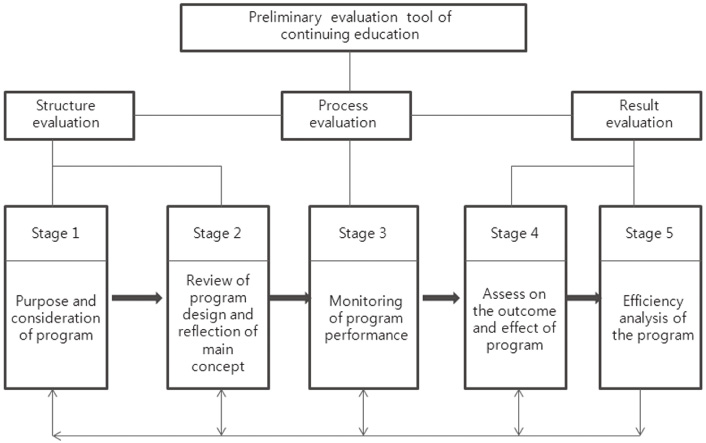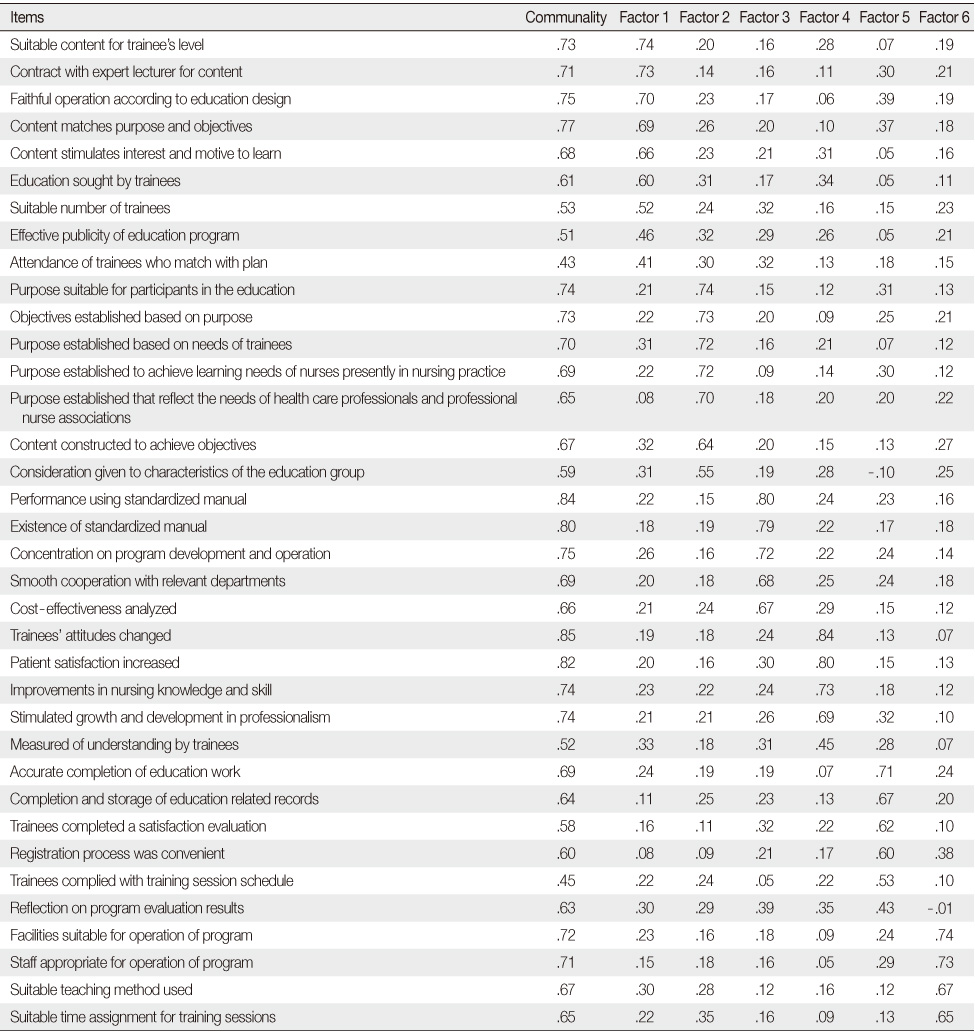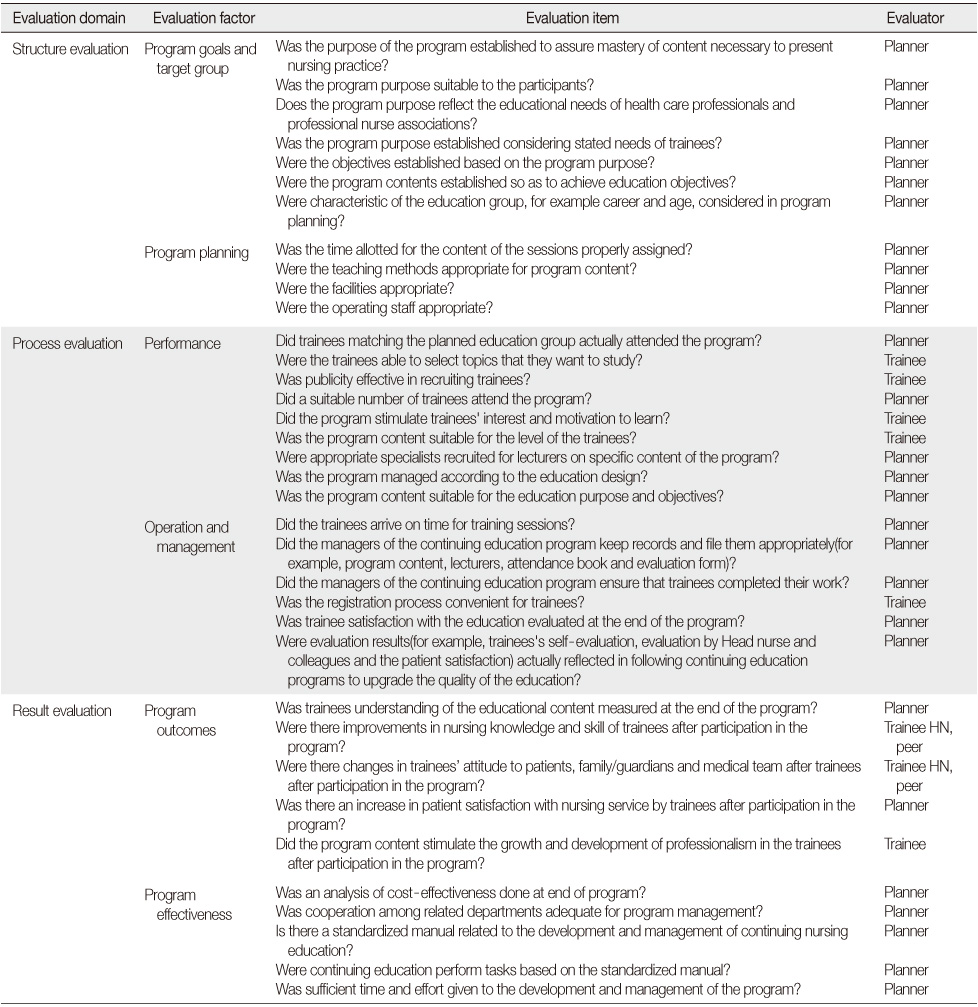Articles
- Page Path
- HOME > J Korean Acad Nurs > Volume 43(2); 2013 > Article
-
Original Article
- Development of the Program Evaluation Measurement of Continuing Nursing Education Programs
- Mi Young Jho, Miyoung Kim
-
Journal of Korean Academy of Nursing 2013;43(2):236-246.
DOI: https://doi.org/10.4040/jkan.2013.43.2.236
Published online: April 30, 2013
1Department of Nursing, Dongnam Health College, Suwon, Korea.
2Division of Nursing Science, College of Health Sciences, Ewha Womans University, Seoul, Korea.
- Address reprint requests to: Kim, Miyoung. Division of Nursing Science, College of Health Sciences, Ewha Womans University, 52 Ewhayeodae-gil, Seodaemun-gu 120-750, Seoul, Korea. TEL: +82-2-3277-6694, FAX: +82-2-3277-2850, mykim0808@ewha.ac.kr
• Received: July 2, 2012 • Accepted: December 24, 2012
© 2013 Korean Society of Nursing Science
Abstract
-
Purpose
- This study was done to develop a measurement tool for evaluation of continuing nursing education programs and to verify its validity for effective management and quality of education programs.
-
Methods
- The draft of the evaluation measurement was developed from consultation with professionals, focus group interviews targeting groups of nurses, and individual interviews with education program planners. After 6 professionals examined content validity, 46 items were retained. A pilot-survey was conducted to confirm the time required to complete the questionnaire and the level of understanding of general content and each item in the questionnaire. Construct validity was verified through exploratory factor analysis of data from a survey with 44 items completed by 452 nurses and 59 education program planners.
-
Results
- The final evaluation measurement for continuing nursing education programs consisted of 6 evaluation factors and 36 evaluation items. The 6 evaluation factors included identifying program goals and target groups, program planning, performance, operation and management, program outcomes, and program effectiveness.
-
Conclusion
- The evaluation measurement for continuing nursing education programs developed in this study is considered suitable to utilize as an evaluation measurement of the quality of continuing education programs for nurses.
This manuscript is based on a part of the first author's doctoral dissertation from Ewha Womans University
- 1. Ahlers-Schmidt CR, Wetta-Hall R, Berg-Copas G, Jost JC, Jost G. Evaluating program effectiveness: Creating a reliable and valid tool. J Contin Educ Nurs. 2008;39(3):139–144.ArticlePubMed
- 2. Alexander GR, Chadwick C, Slay M, Petersen DJ, Pass M. Maternal and child health graduate and continuing education needs: A national assessment. Matern Child Health J. 2002;6(3):141–149.ArticlePubMedPDF
- 3. American Nurses Association. Scope and standards of practice for nursing professional development. 2000;Washington, DC, Author.
- 4. American Nurses Credentialing Center. Application manual: Accreditation program. 2010;Washington, DC, Author.
- 5. Bell DF, Pestka E, Forsyth D. Outcome evaluation: Does continuing education make a difference? J Contin Educ Nurs. 2007;38(4):185–190.ArticlePubMed
- 6. Benner P. From novice to expert: Excellence and power in clinical nursing practice. 2001;Upper Saddle River, NJ, Prentice Hall.
- 7. Bibb SC, Malebranche M, Crowell D, Altman C, Lyon S, Carlson A, et al. Professional development needs of registered nurses practicing at a military community hospital. J Contin Educ Nurs. 2003;34(1):39–45.ArticlePubMed
- 8. Carter LM, Rukholm E. A study of critical thinking, teacher-student interaction, and discipline-specific writing in an online educational setting for registered nurses. J Contin Educ Nurs. 2008;39(3):133–138.ArticlePubMed
- 9. Chae SI. Survey methodology in social science. 2003;3rd ed. Paju, Hakhyunsa.
- 10. Chang KS. Evaluation of intensive in-service English teacher training programs. Foreign Lang Educ. 2007;14(3):257–282.
- 11. Comrey AL. Factor-analytic methods of scale development in personality and clinical psychology. J Consult Clin Psychol. 1988;56(5):754–761.ArticlePubMed
- 12. Donabedian A. The definition of quality and approaches to its assessment. 1980;Ann Arbor, MI, Health Administration Press.
- 13. Edwards H, Walsh A, Courtney M, Monaghan S, Wilson J, Young J. Improving paediatric nurses' knowledge and attitudes in childhood fever management. J Adv Nurs. 2007;57(3):257–269. http://dx.doi.org/10.1111/j.1365-2648.2006.04077.x.ArticlePubMed
- 14. Francke AL, Garssen B, Huijer Abu-Saad H. Determinants of changes in nurses' behaviour after continuing education: A literature review. J Adv Nurs. 1995;21(2):371–377.ArticlePubMed
- 15. Furze G, Pearcey P. Continuing education in nursing: A review of the literature. J Adv Nurs. 1999;29(2):355–363.ArticlePubMedPDF
- 16. Green R, Gorzka P, Kodish S. Achieving excellence in practice: A model for continuing education for nurse practitioners. J Am Acad Nurse Pract. 2005;17(11):452–459. http://dx.doi.org/10.1111/j.1745-7599.2005.00075.x.ArticlePubMed
- 17. Han SM, Lee HS. Nurses' reasons for participation in continuing nursing education. J Vocat Edu Res. 2010;29(2):189–204.
- 18. Hawkins VE, Sherwood GD. The Pyramid model: An integrated approach for evaluating continuing education programs and outcomes. J Contin Educ Nurs. 1999;30(5):203–212.ArticlePubMed
- 19. Kim BK, Park JY. A study on assessment method of program outcomes. J Eng Educ Res. 2008;11(4):46–57.Article
- 20. Kim JA. The development and effectiveness of web-based continuing nurse education program. 2001;Seoul, Ewha Womans University. Unpublished doctoral dissertation.
- 21. Kim JG. Program evaluation. 2002;Seoul, Hakjisa Publisher.
- 22. Korean Nurses Association. The actual conditions and regulation of the continuing nursing education. 2011;Seoul, Author.
- 23. Lynn MR. Determination and quantification of content validity. Nurs Res. 1986;35(6):382–385.PubMed
- 24. Menix KD. Evaluation of learning and program effectiveness. J Contin Educ Nurs. 2007;38(5):201–208.ArticlePubMed
- 25. Nalle MA, Wyatt TH, Myers CR. Continuing education needs of nurses in a voluntary continuing nursing education state. J Contin Educ Nurs. 2010;41(3):107–115. http://dx.doi.org/10.3928/00220124-20100224-03.ArticlePubMed
- 26. Oh YA. Development of evaluation indicator on industrial safety and health education program. 2007;Seoul, Ewha Womans University. Unpublished doctoral dissertation.
- 27. Parker K, Parikh SV. Applying Prochaska's model of change to needs assessment, programme planning and outcome measurement. J Eval Clin Pract. 2001;7(4):365–371.ArticlePubMed
- 28. Russell SS. An overview of adult-learning processes. Urol Nurs. 2006;26(5):349–352. 370. PubMed
- 29. Wise PS. Environmental management: Creating a learning ambiance. J Contin Educ Nurs. 1987;18(1):29–30.ArticlePubMed
- 30. Wysong PR, Driver E. Patients' perceptions of nurses' skill. Crit Care Nurse. 2009;29(4):24–37. http://dx.doi.org/10.4037/ccn2009241.ArticlePDF
REFERENCES
Figure & Data
REFERENCES
Citations
Citations to this article as recorded by 

- A Survey on Nurses' Perception, Satisfaction, and Needs related to Continuing Education
Keum Seong Jang, Eun A Kim, Heeyoung Kim, Seon Young Hwang
Journal of Korean Academy of Nursing Administration.2019; 25(2): 125. CrossRef - Status and Needs of Continuing Education for Trauma Nursing
Yooun-Joong Jung, Suhyun Kim, Sangmi Noh, Eunkyoung Seo, Soyoung Jung, Jiyoung Kim
Journal of Trauma and Injury.2019; 32(3): 157. CrossRef - Perceptions of Continuing Nursing Education in Korea
Mi Young Jho, Youngmi Kang
The Journal of Continuing Education in Nursing.2016; 47(12): 566. CrossRef
Development of the Program Evaluation Measurement of Continuing Nursing Education Programs

Figure 1
Conceptual framework of preliminary evaluation tool of continuing education.
Figure 1
Development of the Program Evaluation Measurement of Continuing Nursing Education Programs
Communality and Factor Loading of Exploratory Factor Analysis
Evaluation Measurement of Final Program
HN=Head nurse.
Table 1
Communality and Factor Loading of Exploratory Factor Analysis
Table 2
Evaluation Measurement of Final Program
HN=Head nurse.
 KSNS
KSNS
 E-SUBMISSION
E-SUBMISSION



 Cite
Cite

